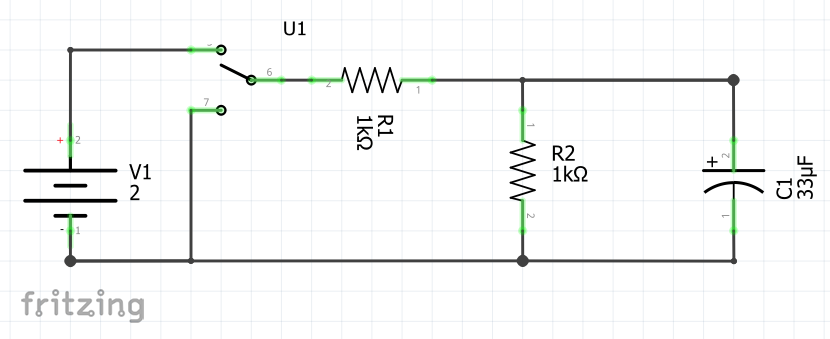All included in LabVIEW Interaction Parts Kit
- Two 1K ohm resistors
- Take them from the small bag on your desk
- One 33 μF capacitor
- Take it from the small bag on your desk
- One small breadboard
- Wires
- Place the 33 μF capacitor on a breadboard, connect the solid orange (OSC1) wire from the OpenScope to the anode (the longer leg) of the capacitor.
- Next, run a 1K resistor from the cathode (the shorter leg) and a wire from the anode to a pin connected to the solid black wire (GND) of the OpenScope.
- Finally run another 1K resistor from the cathode to a pin connected to the solid yellow wire (AWG) of the OpenScope.
These settings are all preset in the LabVIEW VI:
Time
- 50ms/div
Trigger
- Rising edge
- Osc Ch 1
- 100mV
Osc Ch 1
- Volts 200mV
- Offset 400mV
Wavegen
- Square wave
- Frequency 3 Hz
- Amplitude 2 Vpp
- DC Offset 1V
Useful wave shapes can be obtained by using RC circuits with the required time constant. The voltage drop across the capacitor alternates between charging up to Vc and discharging down to zero according to the input voltage. If we apply a continuous square wave voltage waveform to the RC circuit whose pulse width matches that exactly of the time constant of the circuit, then the voltage waveform across the capacitor would look something like this:
If you set up the circuit correctly you should get an output similar to the one seen above. This is in line with our expectations based on the software settings I set in LabVIEW. For more theory and equations, go to Real Analog Chapter 7.
OpenScope MZ is OpenSource!- Schematic
- Mechanical files
- Arduino IDE and MPLAB X
- Browser-based UI (local and remote internet)
- Native iOS and Android Apps On GitHub
- USB/serial communication, setup, local/remote internet connectivity



_ql8lUR9LZz.JPG?auto=compress%2Cformat&w=900&h=675&fit=min)







Comments
Please log in or sign up to comment.